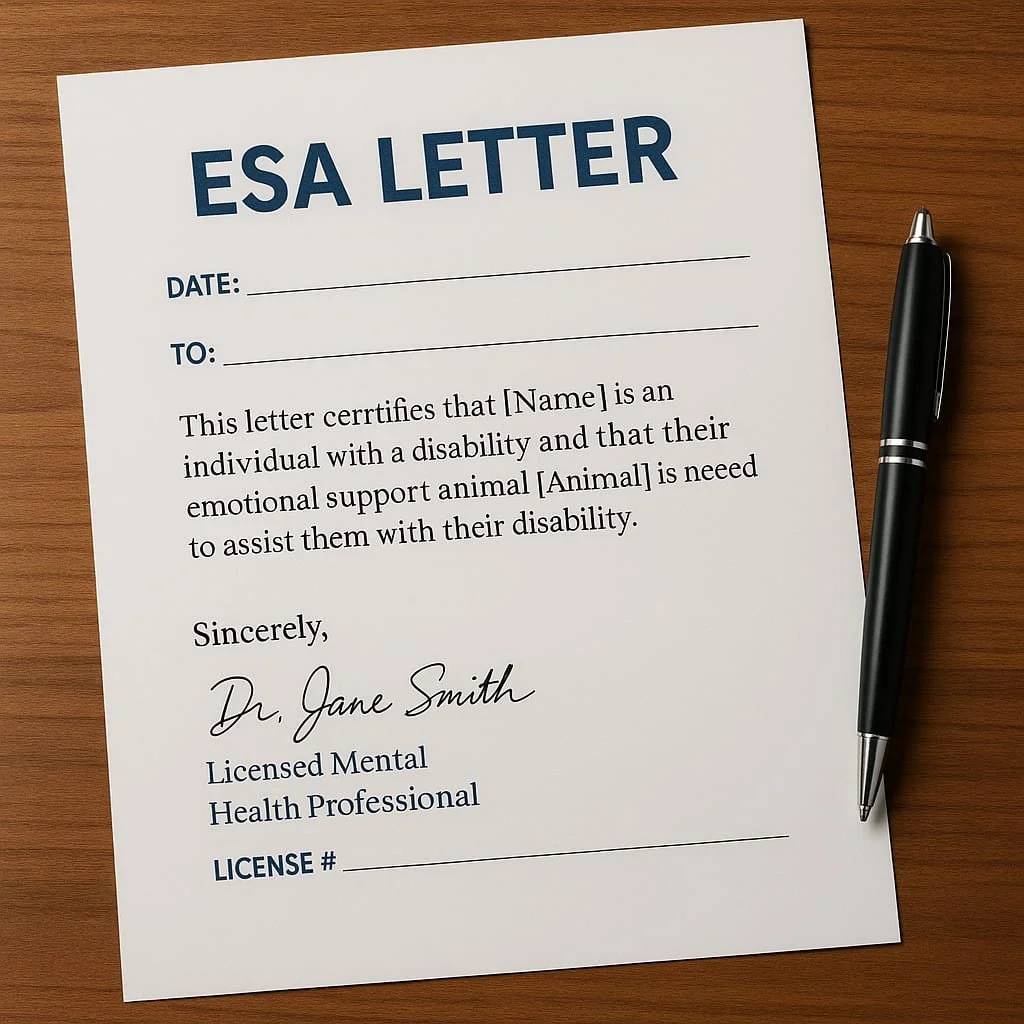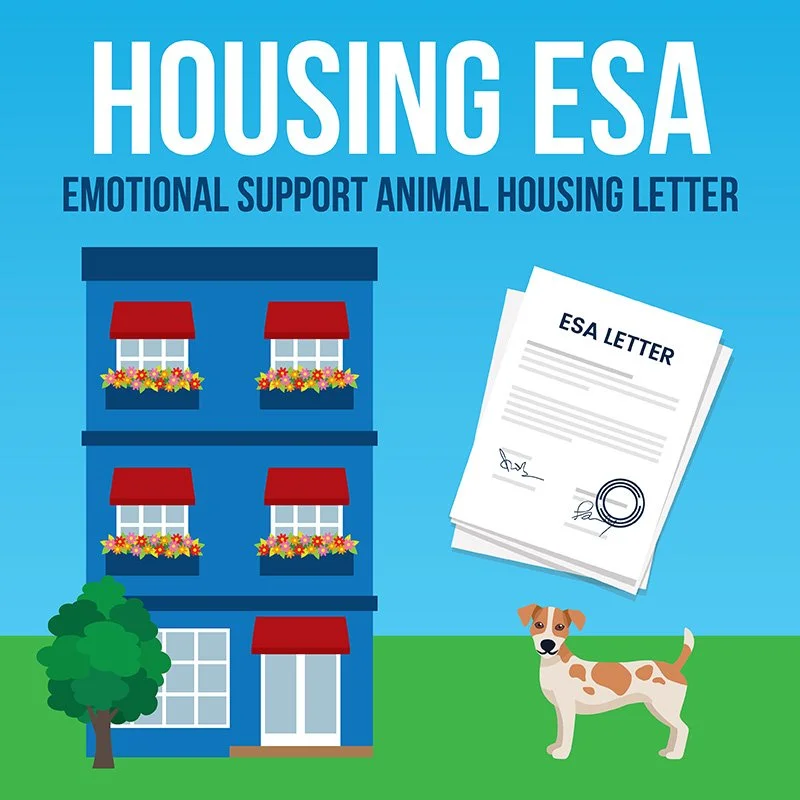For individuals facing emotional or mental health challenges such as anxiety, depression, or PTSD, emotional support animals (ESAs) can be an essential tool for managing symptoms. Many people with mental health conditions find comfort and relief through the companionship of an ESA.
An ESA is a type of assistance animal protected by both federal and state housing laws. To qualify for an ESA, a signed letter from a licensed healthcare professional is required. This document, commonly referred to as an ESA letter, serves as evidence of the need for an emotional support animal.
In this article, we will explain what an ESA letter is and how you can obtain one from a doctor or therapist.
Why is an ESA Letter Important?
The Fair Housing Act (FHA) is the federal law that allows individuals with mental or emotional disabilities to live with their emotional support animals, even in residences that typically do not allow pets. This law protects ESA owners from discrimination and ensures they have access to necessary accommodations in housing.
In addition to federal protections, many states like California, New York, and Florida also have their own regulations that safeguard ESA owners, offering further protections.
These laws highlight the crucial role ESAs play in helping their owners manage their mental health. With the ESA letter, individuals can legally reside with their animals in housing that might otherwise restrict pets. Furthermore, ESA owners are not required to pay additional pet fees or deposits, and breed or size restrictions do not apply to ESAs.
Unlike pets, emotional support animals are considered assistance animals that provide therapeutic benefits to alleviate emotional or mental health symptoms. To benefit from these protections, an ESA letter is required to verify the necessity of the emotional support animal.
What is an ESA Letter?
An ESA letter is a formal document signed by a licensed healthcare professional, stating that an emotional support animal is necessary to help alleviate the symptoms of an individual’s mental health condition. The letter should be written on the healthcare professional’s letterhead and include the following:
The professional’s license number and type (e.g., psychologist, psychiatrist, licensed social worker, etc.).
The date the license was issued and the state where it was issued. The license must be current and active.
A statement explaining that an ESA is essential to reduce the symptoms of the individual's mental health condition.
The professional’s signature and contact information.
It's important to note that an ESA letter is a recommendation, not a prescription. The letter confirms that the individual has been evaluated by a licensed professional and that an ESA is deemed beneficial for their well-being.
An ESA letter must come from a licensed mental health professional, which may include psychologists, psychiatrists, social workers, counselors, nurse practitioners, and other licensed healthcare providers.
Who Can Obtain an ESA Letter?
Not everyone is eligible for an ESA letter. To qualify, you must have a diagnosed emotional or mental health condition that significantly limits at least one major life activity. Common conditions among ESA owners include depression, anxiety disorders, PTSD, autism, and learning disorders. These conditions must impact daily activities such as work, school, or sleep.
Only a licensed healthcare professional can determine whether you meet the criteria for an ESA letter. You cannot self-diagnose or request an ESA letter without professional evaluation.
How to Request an ESA Letter from a Licensed Professional
Asking a healthcare professional for an ESA letter may seem daunting, especially if you're uncertain about their familiarity with emotional support animals. However, it’s important to discuss your mental health openly with your provider, as they are there to support you without judgment.
If you’re already seeing a therapist or other healthcare provider for your condition, your existing provider is your best point of contact for an ESA letter. They will already be familiar with your history and mental health needs. However, not all healthcare professionals may be willing or able to provide an ESA letter due to unfamiliarity with ESA guidelines. If your current provider cannot assist, consider finding a therapist who specializes in ESAs.
What If You’re Not Currently Seeing a Healthcare Professional?
If you're not under the care of a healthcare provider, you can look for professionals who specialize in emotional support animals. Many licensed therapists also offer online telehealth consultations for ESA evaluations, which can be more convenient and less intimidating. Telehealth services are especially helpful for individuals with limited access to transportation or busy schedules.
The U.S. Department of Housing and Urban Development (HUD) allows ESA letters to be issued by telehealth professionals. During the COVID-19 pandemic, this method became particularly prevalent for ESA evaluations.
Obtaining an ESA Letter Online
Online consultations with licensed healthcare professionals have become a popular and convenient way to obtain an ESA letter. Many individuals find telehealth to be less intimidating than in-person visits, and it allows them to seek assistance from the comfort of their own home. Be cautious when choosing online services—ensure you are connected with a legitimate, licensed professional and avoid websites that sell fraudulent ESA certificates or IDs.
How to Approach Your Healthcare Provider for an ESA Letter
If you believe an ESA could benefit your mental health, taking the first step to ask for an ESA letter is a positive move toward improving your well-being. While it may feel uncomfortable, remember that healthcare professionals are trained to provide the best care without judgment. Discussing your needs openly with your therapist or doctor can help you receive the support necessary to enhance your quality of life.
Emotional support animals are becoming increasingly recognized for their therapeutic benefits, and they are legally protected by federal and state laws. To take advantage of these protections, an ESA letter is essential—one that can only be provided by a licensed healthcare professional.












